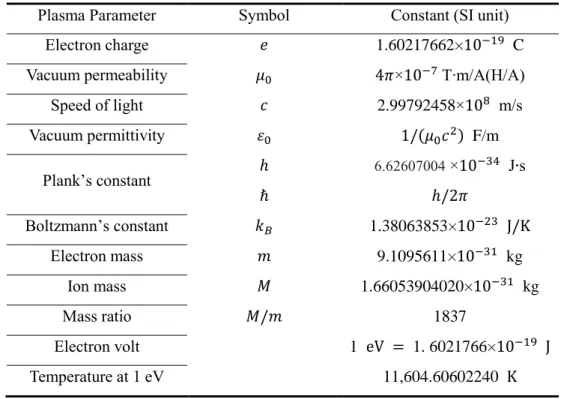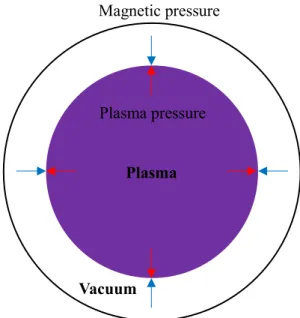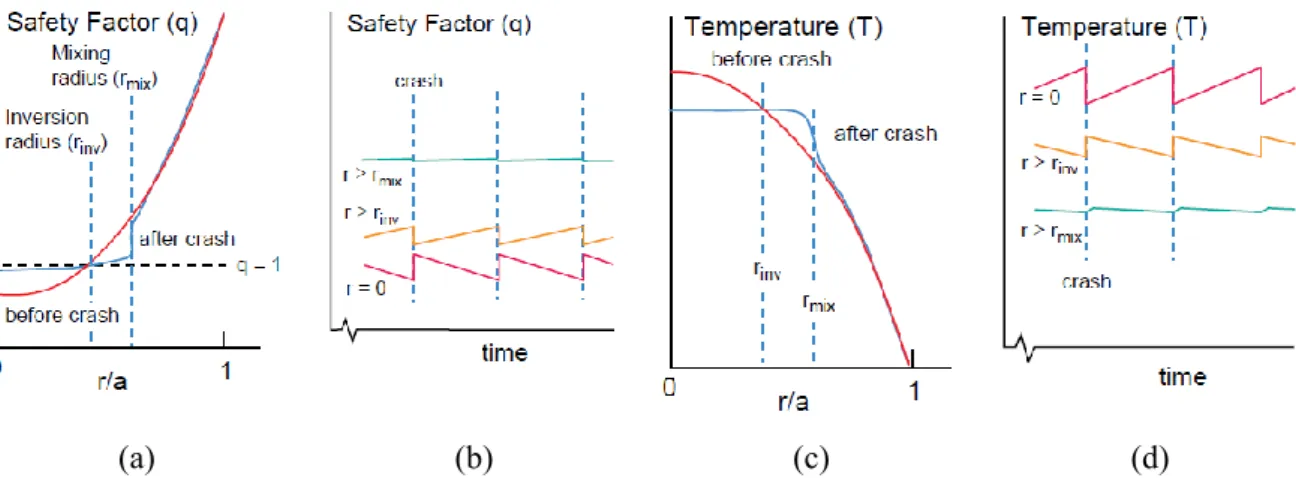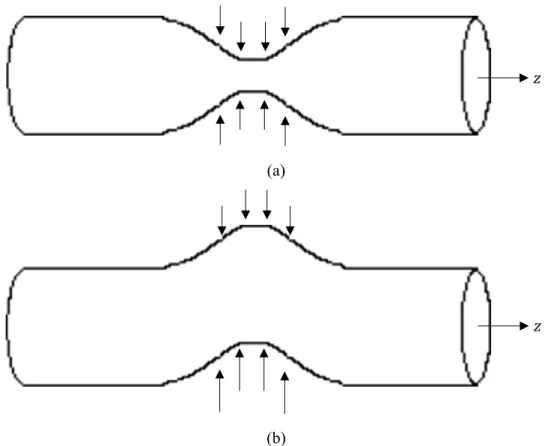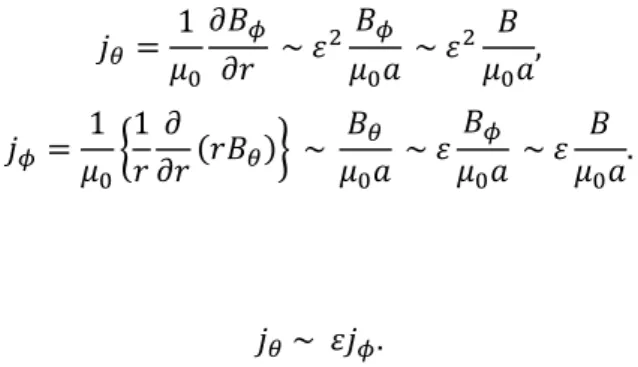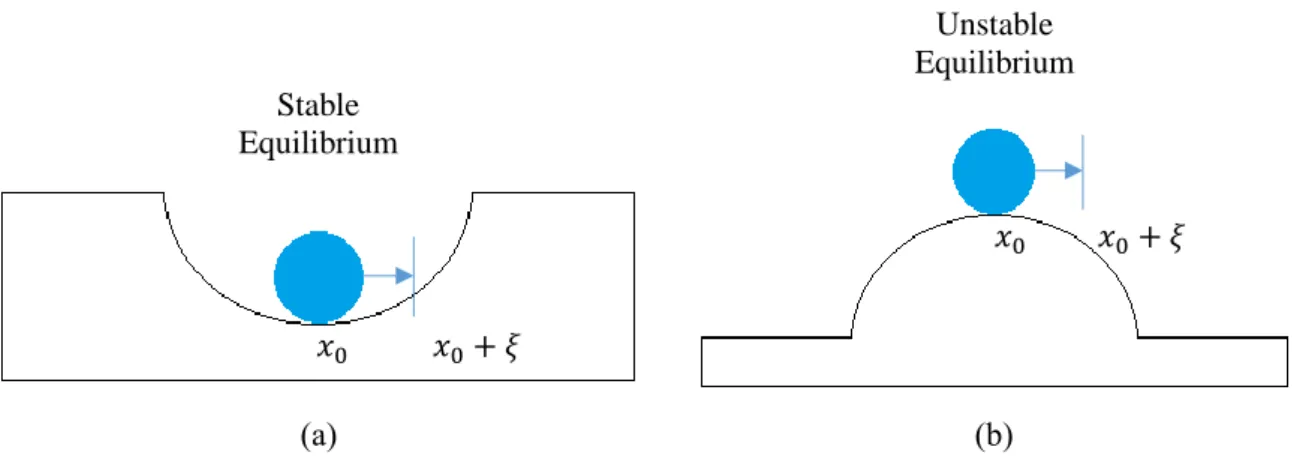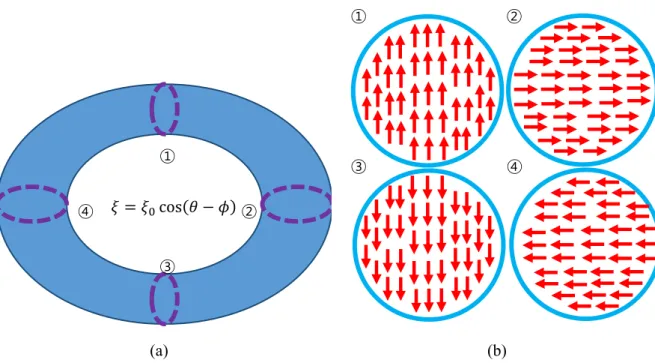Introduction
Motivation
Wesson introduced the “quasi-interchange” model [19] to explain the inconsistencies between Kadomtsev's theoretical model and experimental observation of JET tokamak. As described in Figure 2.1(b), the minor radius, 𝑎, is the plasma radius, and the poloidal radius, 𝑏 is the distance from the magnetic axis to the conducting wall. According to Ampere's law, 'the poloidal magnetic field is induced by the plasma current', as shown in Figure 2.3a [20, 21].
As mentioned in Section 2.1.3, “the magnitude of the toroidal magnetic field induced by the external coil current must be larger than the magnitude of the poloidal magnetic field induced by the plasma current [12] to reduce instabilities. The value of beta, 𝛽, is the 'limiting effectiveness of plasma pressure by magnetic pressure' [29] or expressed as. where 𝐵 is the magnitude of the magnetic field or 𝐵2= 𝐵𝜙2 + 𝐵𝜃2. 2.28) 𝑟-component of the equilibrium equation, Eq. According to the result, if the tokamak satisfies 1 − 𝑞 > 𝜀, the instability follows the Kadomtsev model, and if the tokamak satisfies 1 − 𝑞 ≪ 𝜀, the instability follows the Wesson model.
Stacey, "The Quest for a Fusion Energy Reactor: An Insider's Account of the INTOR Workshop", New York: Oxford University Press (2010).
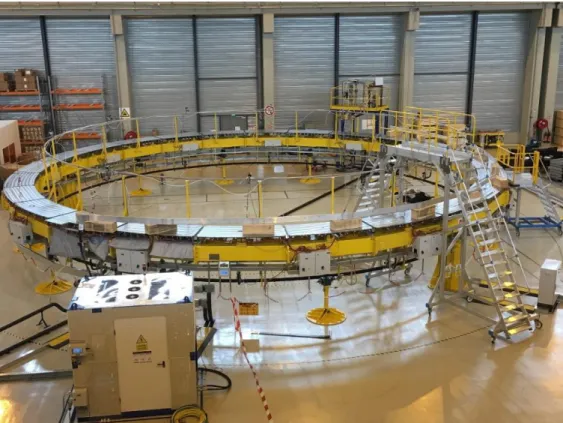
Fusion energy and tokamak
Background of this study
The shape of the 1-D time trace of core temperature over time appears similar to a sawtooth. As Figure 1.5b, the periodic sawtooth cycle can be divided into 3 phases: .. i) Ramp phase: The plasma density, 𝑛(𝑟, 𝑡) and temperature, 𝑇(𝑟, 𝑡), are increasing approximately linearly with the passage of time. ii) Precursor phase: Due to instability, the spiral magnetic perturbation is increasing. iii) Rapid collapse phase: The plasma density, 𝑛(𝑟, 𝑡) and temperature, 𝑇(𝑟, 𝑡), decay rapidly with respect to time. Due to the instability, the heat in the core is transported to the outer region of the tokamak.
The inversion radius, 𝑟inv is at the radial position of 𝑞 = 1, that is, inside the inversion radius is 𝑞 < 1 and outside the inversion radius, 𝑟1, there is 𝑞 > 1. In addition, the radius is the affected mixing region from the collision in the core. Outside the mixing zone, the temperature and safety factor do not change with the collision.
Safety factor versus time (c) Temperature versus radius (d) Temperature versus time [15].
![Figure 1.5 (a) The periodic behavior of electron density at JET tokamak, and (b) the ion temperature description of sawtooth plasma [14]](https://thumb-ap.123doks.com/thumbv2/123dokinfo/10494618.0/24.892.120.785.127.563/figure-periodic-behavior-electron-density-temperature-description-sawtooth.webp)
Thesis Outline
Theoretical & Mathematical Development
MHD Physics Review in Tokamak
- MHD equations
- Mathematical Description in Tokamak
- The 𝑧-pinch configuration
- The Screw Pinch Configuration
- The Safety factor, 𝑞
- The Beta, 𝛽
- Properties of large aspect ratio in tokamak
The 𝑧-pinch is the configuration in which the direction of the plasma flow is the 𝑧-direction. As mentioned in section 2.1.2, the 𝑧-pinch is the direction of plasma flow in the 𝑧-direction. To explain it in words, the safety factor is the ratio of the number of toroidal turns to the corresponding poloidal turns when the magnetic field line moves spirally in tokamak.
This is the definition and process of calculating the safety factor, 𝑞(𝑟) with arbitrary current profile, 𝑗𝜙 = 𝑗𝜙0(1 − 𝑟2/𝑎2)𝜈. The change in kinetic energy from the perturbation is where 𝐟1 is the first order perturbation of the force density. This is the entire derivation process for the potential energy change, 𝛿𝑊, in the tokamak using
This is the theoretical overview of Kadomtsev's model to observe fast accident through magnetic reconnection. The old magnetic island suddenly disappeared, and the electron temperature fluctuation distribution returned to initial state, which is the first state of the stable ramp phase.
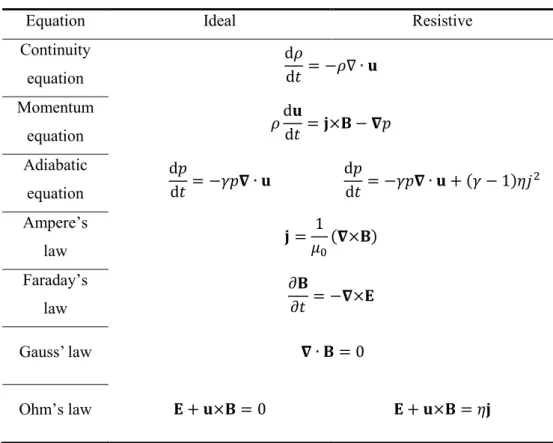
Reviews of MHD instability in tokamak
- Basic idea of MHD stability
- Energy principle
Theories of sawtooth instability
- Internal kink, 𝑚/𝑛 = 1/1 mode
- Kadomtsev’s model
For the external mode, stability is achieved by both the integral term and the other term of Eq. Kadomtsev's model tries to explain the instability by taking d𝜉/d𝑟 → 0 inside the 𝑞 = 1 surface [30], while Wesson's model tries to explain the instability by taking 𝑞 → 1 inside the 𝑞 = 1 surface. The velocity, 𝑣1, is the velocity of the hot core and the velocity, 𝑣2, is the plasma velocity coming out of the narrow layer.
As the temperature in the core increases, 𝑞 = 1 surface appears and instability occurs as in Figure 2.9 (b). The core begins to move due to an internal kink, and a new magnetic island appears on the other side, resulting in two apparent islands. One magnetic island has 𝑞 < 1 due to internal buckling, while the magnetic island on the other side has 𝑞 > 1.
A magnetic island that has 𝑞 < 1 is destroyed by magnetic reconnection, whereas the new magnetic island that has 𝑞 > 1 expands. After the old magnetic island is completely annihilated, it returns to the original state as 𝑞 >. To explain this inconsistency, Wesson assumed a flat 𝑞 profile inside the 𝑞 = 1 surface. 2.103) and the corresponding displacement distribution [18] is illustrated in figure 2.10.
In this model, there is no magnetic shear stress inside the surface 𝑞 = 1 due to the magnetic shear stress, given in Eq. Due to the absence of magnetic shear, the magnetic surface deforms into a crescent shape and cold plasma enters the core as shown in the figure. The magnetic reconnection takes place during the ramp phase and not during the rapid collapse phase [18].
Model Fast-reconnection model Quasi-exchange model. 𝑎 0. 3𝑞)} 𝜉2𝑟𝑑𝑟 Flow structure Hot bubble, cold crescent Hot crescent, cold bubble.
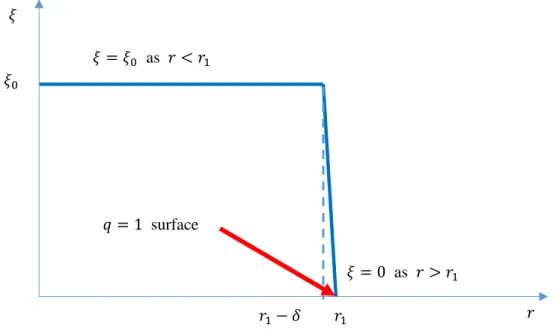
Experimental Methods
KSTAR ECEI System
- Physical principle of ECE
- KSTAR ECEI System
Experimental Set-up
The intrinsic rotation experiment #11264 is used to observe the sawtooth oscillation in 3D with the KSTAR ECEI system. In the next chapter, the experimental results are shown and discussed based on the results.
Results & Discussions
Experimental results
- Observation of periodic behavior
- Observation of precursor phase
- Observation of fast crash
The observed sawtooth period, theoretically calculated Kadomtsev's collapse time, and the observed collapse time are shown in Table 4.2. According to the results, the observed collapse time is very short compared to the sawtooth period, i.e. 𝜏𝑐/𝜏sawtooth ~ 10−2. The entire periodic behavior of the central region (observed in high field side of H port) and the outer region (observed in G port) is shown in Figure 4.2.
The old magnetic island and new magnetic island were observed alternately, as plasma was observed to rotate. In the precursor phase, the temperature reached critical temperature, and the hot core began to move through internal torsion. On the other side of the hot core plasma, a new magnetic island appeared, and a new magnetic island grew.
The preliminary phase and the rapid collapse phase in the central region and the outer region are shown in Figure 4.4. In the stable ramp phase, the plasma at the core appears to have stopped rotating, but when the new magnetic island appeared, the hot core plasma appeared to be rotated in the poloidal direction. At the local maximum in Figure 4.4, the old magnetic island is shown, and at the local minimum in Figure 4.4, the new magnetic island is shown.
To calculate the disturbance period, as illustrated in Figure 4.5, the poloidal angular velocity must be calculated. The poloidal rotation period of both the theoretically calculated value and the observed value are roughly similar. The collapse was observed when the magnetic reconnection caused the hot core to move outward.

Discussions
The real part of 𝜔, 𝜔𝑟, will represent the rotation speed of the plasma observed in section 4.1.2. The instability is 𝑚/𝑛 = 1/1 internal kink mode, then the displacement is expressed as 𝛏 ~ 𝑒𝑖(𝜃−𝜙−𝜔𝑡), then the poloidal rotation period and the toroidal rotation period will be. By obtaining the growth rate, the variables that can affect the growth rate will be identified.
Conclusion
제가 공부하는 동안 많은 지도와 조언, 지도를 해주신 박형어 교수님께 머리 숙여 감사의 말씀을 드립니다. 그리고 시간을 내어 논문을 검토해주신 곽규진 교수님, 허민섭 교수님에게도 감사드립니다. 특히 인생의 선배로서 가끔 조언을 해주신 곽규진 교수님께 감사의 말씀을 전하고 싶습니다.
실험실에서 연구하는 동안 저를 도와주시고 조언해 주신 의사들에게 감사의 말씀을 전하고 싶습니다. Dr. Dr.에게 감사드립니다. 연구실을 운영하고 연구실의 모든 구성원을 돌봐주신 김민우님. 박사님께도 감사의 말씀을 전하고 싶습니다. 연구분야를 직접 지도해주신 남윤범 교수님.
박사님께도 감사의 말씀을 전하고 싶습니다. 이재현님, 질문에 친절히 답변해 주셨네요. 행정업무에 수고해 주신 정유진 선생님께도 감사드립니다. 제가 빛의 교회에서 정말 힘들 때마다 먹을 것을 주시고 격려해 주신 신광호 목사님께 감사드리고 싶습니다.
또한 제가 신복교회에서 신앙생활을 하면서 도움을 주시고 지지해 주신 모든 분들께 감사의 말씀을 전하고 싶습니다. 늘 설교해주시는 김규섭목사님, 재강목사님, 박규태목사님께 감사드립니다. 항상 나를 따뜻하게 맞아주고 보살펴 주는 아내에게 감사하다는 말을 전하고 싶다.
부모님의 은혜를 통해 하나님의 은혜를 느낍니다. 멀리 떨어져 있어도 부모님과 연락을 주고받으며 우리의 어려움과 고민을 나보다 더 많이 나누었고, 평생을 함께 보내도 결코 보답할 수 없을 것입니다.
